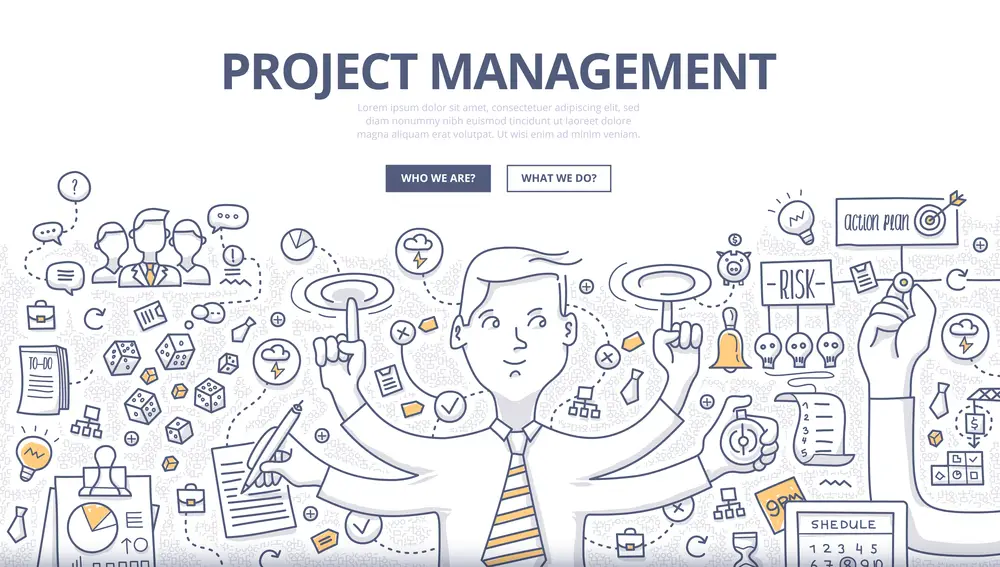No project is without risk—but that doesn’t mean your project is doomed to fail. Risk management is the process of identifying, assessing, and mitigating risks to ensure your project’s success. Taking a proactive approach to risk management can increase the likelihood of your project’s success while minimizing potential impacts on scope, schedule, and budget. Risk management is one of the important project management skills a project manager can possess.
1. Identify Risks
The first step to managing risk is identifying internal and external risks that could potentially impact your project’s success. To do this, consider the following questions:
– What could go wrong?
– What are the consequences if something does go wrong?
– How likely is it that something will go wrong?
Once you’ve identified potential risks, you can begin assessing them.
2. Assess Risks
To assess risks, you’ll need to consider two things: the impact of the risk and the likelihood of the risk occurring. The impact is how much of an effect the risk will have on your project if it materializes. The likelihood is just what it sounds like—the chance that the risk will actually come to pass. The role of project manager during risk assessment is critical in risk analysis.
To assess risk, simply multiply the two values together to get a number between 1 (low impact/low likelihood) and 25 (high impact/high likelihood). This will give you a quick way to prioritize which risks are most important to focus on.
3. Mitigate Risks
Now that you’ve identified and assessed your risks, it’s time to mitigate them. To do this, you’ll need to develop response strategies for each of your identified risks—strategies that will help you avoid or minimize the impact of negative events should they occur.
When developing response strategies, be sure to involve relevant stakeholders so that everyone is on board with the plan—and be sure to document everything. Hence, there’s a record of what has been decided in case things go wrong further down the road.
4. Monitor Risks
Risks can change over time, so your response strategy needs to be flexible enough to change with them. As such, it’s important to periodically monitor risks throughout the course of your project to ensure that your response strategies are still relevant and effective. If a risk does materialize, be sure to document what happened so that you can learn from the experience and apply those lessons learned to future projects.
In the course of the project, the risk is inherent in every aspect, and Project Risk Management is a crucial subject in team discussions. It’s also the reason that many of the major projects are prone to problems. Experienced project managers would manage risk by doing research that shows how quickly a risk can cause real problems in projects and organizations.
When budgets and deadlines have passed almost 50%, we can quickly see why this risk is so high. There are also ways to minimize or manage the risks. If the project management processes are good, the team can effectively identify and control the risks. Monitoring happens through a project risk register.
Risk management is a very relevant term for project managers. With an increasingly advanced computer system, the ability to assess risk has become more effective than ever. As a result, risk management has grown in popularity recently as organizations and project managers incorporate risk management into project management.
Getting started in the planning phase can often be a difficult decision. If project managers are pragmatically aware, these thoughts can be prevented. Issues can often occur, and you must develop an effective risk management plan.
As projects evolve, businesses must manage the risks of these changes. The growing demand for professional project management professionals shows there will be 22 million jobs in this sector by 2027. For people seeking to get a position within project management, a strong risk management capability is critical to a successful job search by employers.
Do you feel like you’re constantly playing catch-up on your projects? Are you worried about meeting deadlines or delivery milestones? You’re not alone. Risk management is an important part of any project plan, but it can be tricky to know where to start. Today we’ll walk through some steps to help you get started.

What is the positive risk?
Some risks are not all equal. Risk is either favorable or negative, although many assume it is inherently a risk. When negative risks refer to things that are unwanted and could permanently damage projects, positive risks are opportunities that can impact projects positively.
Negative risks are part of any risk-management plan as positive risks do. You control and manage known adverse risks and mitigate the effects, and positive hazards are also managed so you can take full advantage of them.
Steps in the Risk Management Process
Identify the Risks
Risks can easily be identified. When you complete this step, you should gather information in risk registers. You could brainstorm in person or through a colleague or stakeholders. Find the right people for the job and arrange an interview. Make a similar comparison to previous project data. Your threat list will now be expanded. Check that the potential risk can be found within the cause.
Analyze the Risk Analysis
Analyzing risks can be tough. It’s impossible that I have a lot of information. Some information may be complicated, and others may be useful in a risk analysis. It may surprise you to find that a business already exists in this field as well.
When you assess the risk for your project, the study’s outcome will help you mitigate the impact of the study. What are some good ways to analyze risks on projects?
Prioritize the Risks
There is no universal risk. You must evaluate the risks to know how to gather resources that will solve the issue. However, it is easy to deal with risks classified as high, medium, and low.
This perspective helps plan the best way of addressing these risks. Potential problems must be addressed immediately. This is an obstacle to any project that may fail you. Other risks are significant but may not affect your project. It’s your job to act based on it.

Respond to the Risks
First, you must know whether it’s a good or a negative possibility. Can we use this information to improve a project? In this case, there is a risk mitigation plan in place. Risk mitigation strategies can be regarded as a plan designed to minimize the risk associated with an undertaking’s risk.
Depending on your risk, your actions can be based on your priority. Communicate with the risk owner and decide what plan will be implemented to mitigate this risk. The project team can identify risks using project management software.
Assign an Owner to the Risk Management
It takes a lot of time to determine risk, but it will fail when no one is assigned to manage it. Definitely, this should be a consideration when listing a potential risk. Some people have more expertise in specific risks. Then this person must take responsibility for this issue. Perhaps arbitrary decision. Of course, you’d be more likely to assign that job to the appropriate person.
Monitor the risks
You cannot force yourself to take risks by not monitoring the progress of your initiative. This is where surveillance happens. Whoever owns the risk must monitor the progress toward the solution. You must be continually updated to understand the project’s progress and identify potential risks.

Managing Risk throughout the Organization
The goal of any risk management strategy is to minimize the impact of negative events. For example, if an organization is exposed to the risk of fire, it might purchase insurance to cover the cost of rebuilding in the event of a fire.
Or, if an organization is worried about the future price of a raw material, they might hedge their bets by signing a contract to purchase the material at a set price. Diversification is another common risk management strategy.
While there is no guaranteed way to eliminate risk completely, managing risk is essential to the long-term success of any organization.
The use of risk management protocols can significantly reduce the cost of operations. It’ll be less hassle if someone is reworking a previous project’s risks.
How to manage risks on projects
Managing a project is a crucial tool. The resulting plan helps reduce the costs of uncertainty and reduces the costs of the investment by reducing time, resources, earnings, assets, and personnel.
Identify project risks
Brainstorm any current risks in a project with key stakeholders. Get people to explain what’s essential to complete the job. Talk to people who have problems. Identify risks associated with project needs and technology, materials, and budget. This is the first step in the project risk management process.
Implement risk responses as early as possible
Having a risk management strategy will help define your risk profile a lot better if the project implements the right risk mitigation strategy to meet your objectives. Additionally, there are three possible outcomes for risk acceptance, avoidance, and minimizing.
The effects of a project should be limited if possible, or a project can’t be manipulated easily, but the person should take risks. While not risky, planning or manipulated projects are possible, so there’s a less likely chance that you encounter any particular risk. To minimize possible danger, you should try influencing or strengthening favorable aspects to compensate for risk effects.
Prioritize risks
Risk is divided into two categories: Low Risk and High Risk. As its name suggests, Low Risk is a risk that can affect an event yet is manageable. The risk is incredibly high, which could negatively affect the outcome and stop progressing quickly. Not all risk are prioritized.
Therefore the risk has a bigger influence than others. Spend an extensive amount of time defining risks and their impact on projects. It is possible to choose one of the criteria to assess or prioritize risk simply by feeling. The best method is a realistic approach that allows one to evaluate potential risks/effects in prioritizing risks.
Analyze risks
Risk analysis is an essential aspect of risk management that can really aid in making serious decisions about projects and services. Therefore, understanding risks is very important. Never forget that risk analyses are not purely a one-dimensional process and can take place on multiple levels as well.
Some small, harmless risks can become large and cause serious consequences. It is at that point when a project manager can be very effective. This type of analysis is useful for measuring the impact on budgets, timeframes, and product quality of projects.
Include risk management in your projects
The easiest way to increase project management is to implement risk management into project management. Today, many organizations introduce project management tools that help employees to detect and mitigate risks.
For detecting risks, it is important that team members are well-equipped to analyze future scenarios. With professional project managers, you can organize risk brainstorms to discover potential problems in the future. Various risk identification techniques can help you identify unexpected risks.
Communicate risks to others
Does someone predict risk during meetings? In these areas, there must be risk communication. A big failure can be easily resolved in most situations through a consistent communications strategy. It would probably work well for everyone to be aware of the risks on the job. Tell us about the risks of a project, the likelihood that it will happen, and what actions will be taken.
Create a project risk register
A risk register lists potential risks that could impact a project. It includes information on each risk’s likelihood and potential impact, as well as plans for how to mitigate or avoid the risk.
Creating a risk register is an important part of project planning, as it helps to identify possible risks early on and develop strategies for dealing with them. The process of creating a risk register can be broken down into four steps:
Create risk registrations for XML files. Input fields describing risk type, risk probability, risk impact, owner, risk response action, or status. It is important that the project risk management framework has an objective tracking system.

Conclusion
Managing risk is essential to any project manager’s job—but it doesn’t have to be overwhelming. By taking a proactive approach and following these four steps, you can increase your chances of project success while mitigating potential impacts on scope, schedule, and budget.

Chris Ekai is a Risk Management expert with over 10 years of experience in the field. He has a Master’s(MSc) degree in Risk Management from University of Portsmouth and is a CPA and Finance professional. He currently works as a Content Manager at Risk Publishing, writing about Enterprise Risk Management, Business Continuity Management and Project Management.

